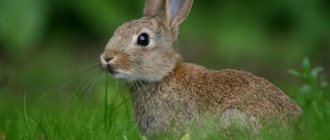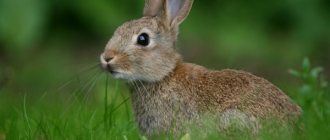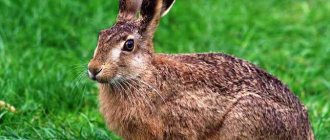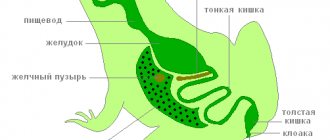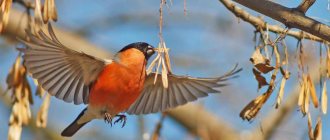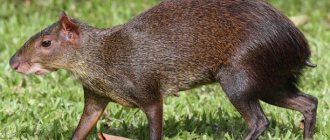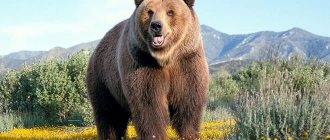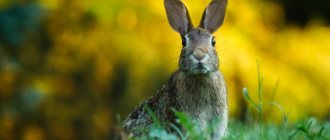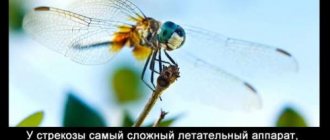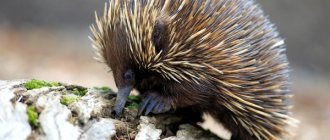№1
Many people think that hares and rabbits are very similar. Yes, at first glance they seem the same, and they belong to the same family Leporidae (hares). But in reality these are quite different species. Rabbits, unlike hares, are born naked, while hares are born with fur. Hares are also much larger than rabbits. Their ears and paws are much larger. Also, rabbits living in the wild build their houses underground, in burrows, while hares build their nests on the surface.
Amazing abilities of hares
Many have probably heard how these nimble animals briskly beat off shots on logs or stumps. But not all children and adults know the interesting fact that this is how hares communicate with each other. Furiously pounding the ground with their hind paws, they warn their fellow tribesmen that the enemy is approaching. At the same time, the drummer himself, who makes sounds and thereby attracts attention to himself, often becomes a victim of this predator, but gives his relatives the opportunity to hide in the wilderness. The hum produced when the paws hit the ground can be compared to the sounds of a tom-tom, which was used by ancient tribes of people to transmit signals. Research shows that such a sound is heard much better than the screams of relatives.
In addition to stomping, they use various types of pats and release special odors into the air that correspond to different situations.
As for the sounds made by the speech apparatus, long-eared animals can grumble while chewing food, and also scream shrilly in case of danger. Hunters who are “lucky enough” to hear the heartbreaking cries emitted by hares note that they are somewhat reminiscent of the crying of a baby or the inviting cries of a cat.
The common fact that hares are herbivores is wrong. Yes, they love to eat juicy grass. But with the same success they are ready to taste meat, for example, insects and small rodents. Northern hunters setting snares for partridges repeatedly noticed that if the trap is not checked in time, ahead of the long-eared one, the prey will be eaten.
For the same reason, scientists who have been studying these animals for a long time initially classified them as a species of rodents, and having identified the taste preferences of long-eared animals, they were classified as a separate series of lagomorphs.
People who keep rabbits note that these animals love to eat their droppings. Their wild relatives, hares, also suffer from the same “weakness.” The fact is that soft green droppings contain enzymes that help speed up the digestion process. Watching these animals, you notice that they are constantly gnawing on something. This is more likely not a feeling of hunger, but a physiological necessity. Hare teeth grow throughout life, and therefore they have to be ground down regularly.
Amazing animals are often called “oblique”. They received this nickname not because of vision problems, but because of their ability to circle while escaping. While running away, they manage to make a turn, returning to the same place from where they started. This ability is explained by the structure of the hind legs. They are more developed than the front ones, but at the same time they differ in length. In nature, there are both right-handed and left-handed hares. The looping run created due to the uneven length of the paws makes long-eared animals elusive prey for predators.
If we talk about their ability to move quickly, then hares are real sprinters among small animals:
- the height and length of the jumps of these animals reaches 3.5 m;
- speed during the chase is up to 80 km/h.
These animals easily overcome rocky terrain and swim well. Eared animals have very strong hind legs. During the mating season, they use them to fight rivals and
Many children will probably be interested to know the fact that hares, like lizards, are able to give up their tail in the name of salvation. This often happens when a predator catching up with an animal manages to scratch the victim by the tail. At this moment, the fur is removed along with the skin, thereby diverting the attention of the predator and giving the victim the opportunity to win a couple of seconds necessary for salvation.
Hares can live in families or settle as individuals. The way of life can be either sedentary or “tumbleweed” type.
With a sedentary way of life in the adjacent territory, sometimes reaching 6-10 hectares, these animals form a complex intertwined system of routes. It combines feeding and surveillance areas. The animals carefully monitor the maintenance of order on the paved paths, from time to time cleaning them from leaves and branches. This procedure is necessary to make it easier for the animal to escape in case of danger.
№5
They have excellent vision, excellent hearing and an incredible sense of smell. Hares have really good eyesight. Due to the lateral position of their eyes, they can see almost 360 degrees. This suggests that it is almost impossible to sneak up on this animal unnoticed, even from behind. For example, a person can only distinguish objects within a range of 180 degrees.
This is one of the fastest land mammals
Hares do not have effective self-defense tools. Wolves, foxes, coyotes and many other predators love to feast on these rodents. That is why, in the process of evolution, they developed a very high speed, which can reach 72 km/h. As soon as he sees danger, the long-eared one immediately rushes to his heels. At the first opportunity, he tries to hide from the predator in the thickets.
Photo: Jo Garbutt/Flickr
№6
They usually lead a cowardly lifestyle, hiding in a shelter during the day, and going out to hunt in the evening and at night. However, there are periods in their lives when they become very brave. This happens in the spring, when mating season begins.
At this time, they begin to chase each other (applies to males) in order to win the favor of the female. During the mating season, you can often observe clashes between males who literally engage in boxing. It is worth noting that they go so crazy that they run after one female in groups of 5-6 individuals, constantly getting into skirmishes with each other. At this time they are very vulnerable, as they do not notice predators.
Nomination record holders
Of no less interest may be the fact that among these inconspicuous at first glance, but so amazing animals, there are record holders. The average weight of hares ranges from 1.2-1.6 kg. This parameter depends on the type of animal and the abundance of food.
The largest representative of the family, who lived on the island of Minorca about 12 million years ago, is recognized. This is confirmed by the fossil remains found by archaeologists, judging by which the animal weighed about 15 kg.
The record holder for ear length is rightfully considered to be a representative of the hare family - a rabbit called the Brussels ram. The animal's ears, located on the sides of the head, are collected into balls. When extended, they reach a length of 3 meters.
If we mention the rarest representatives of the family, then we should include tree hares among them. These animals do not rush through the fields, but jump through the trees. They are found in two geographical locations in the world: on the islands of Japan called Toku-no-Oshima and Anami-Oshima. Since fifty years ago, there were only 500 of them. It is not known exactly what their number is today.
Water hares will soon be considered among the rarest representatives. Their numbers are declining at a rapid rate due to the disruption of the ecological balance of the southern United States. Representatives of this breed got their name due to the fact that in case of persecution they escape by hiding in bodies of water. They know how to dive into the water, exposing only their tiny nose above the surface of the water. They can remain in this position for tens of minutes. When the danger has passed, the animals begin to quickly row to the other side.
Do we really care or...
The hare is not one of the timid animals. With the help of his hind legs, he can quite successfully fight off his natural enemy. Hares, protecting their offspring, can tear apart an adult crow; this bird can calmly tear apart a young hare. Such mothers stay with their offspring for only 5 days.
There are cases when adult hares forced small dogs to run away. Old individuals, in front of a chain dog choking with a loud bark, can indifferently eat cabbage, carrots and everything that turns out to be pleasant to their taste in the garden. The hare will never eat his meal in the garden if he sees a scarecrow there. The garden guard apparently instills in the animals not only fear, but also respect, so that hares prefer to visit only those gardens that are not guarded by scarecrows.
Excursion into history
In the 4th century BC, on the Greek island of Samos, there was the main sanctuary of the goddess Hera; in ancient times, a huge number of statues dedicated to the wife of Zeus could be seen there. One of these statues pleases the eyes of tourists visiting the Louvre and is called “Goddess with a Hare”. Historians believe that this marble image of the animal is not the only one. Among early Christians, the image of a hare was considered a symbol of a repentant sinner who, after long wanderings, decided to return to God. Such people were considered timid and fearful, but the animals with which sinners were personified are not so cowardly at all. There are cases when adult individuals calmly fought back against foxes, eagles and even small dogs, using their powerful hind legs as a means of defense.
What does it eat?
Based on their feeding method, hares are classified as phytophages—animals that feed on plants. The animals have no special food preferences. They eat grass, young shoots and tree bark, berries, mushrooms, and plant tubers. These are one of the few herbivores that are able to eat even some poisonous plants.
In the summer, hares find food in the forest, in clearings, and in thickets of bushes. In the cold season, when there is a lack of food supply, animals can get close to settlements, nibbling young seedlings in gardens and collecting the remains of crops left in fields and vegetable gardens.
Due to the fact that plant foods do not contain many nutrients, the digestive system of hares is adapted to digest significant volumes of food. To break down all the food that enters the stomach, a sufficient amount of enzymes is required. Hares eat their droppings when they feel a lack of enzymes. Soft green droppings can speed up the digestion process. It contains the necessary bacteria. Animals do not eat solid black droppings.
Nutritional Features
The diet of the brown hare varies depending on the time of year.
Summer diet
In summer, the animal has the most varied diet. It feeds mainly on plants, consuming up to 500 species of grasses and small shrubs.
The brown hare, like its close relative the hare, does not miss the opportunity to feast on melons, fruits or vegetables growing in agricultural fields. By making frequent raids, russians are capable of destroying more than 50% of the crop in a season.
Winter diet
In winter, the diet of hares consists of berries and fruits left on bushes and fruits.
They also begin to consume tree bark. Brown hares especially love to eat the bark of soft trees (aspen, birch, willow, etc.).
In winter, animals come as close as possible to populated areas, and, raiding households, gnaw the bark of fruit trees, feast on hay and straw, and vegetables prepared by people for the winter.
Autumn and spring diet
In autumn, the hare's diet consists of branches of large and small shrubs. They also consume fading grass and roots of plants located close to the surface of the earth.
In spring, young shoots, buds of bushes and trees, and fresh grass appear in the diet. Also in the spring, rabbits feast on animal bones, small stones and earth. This helps to compensate for the lack of minerals and vitamins resulting from a poor winter diet.
How a hare prepares for winter
molting
The hare's main defense from enemies is the ability to hide. Since gray or brown fur will immediately give away an animal in winter, the animals change the color of their coat. Shedding begins at the end of September, and by the beginning of winter the hare is completely covered with white fur or becomes significantly lighter in color.
During the winter months, not only their appearance changes, but also their habits: hares spend most of the day in holes dug in the snow, leaving the shelter exclusively at night and only to search for food.
To the hare - glory and honor
On the territory of the Russian Federation in the city of Kovrov, which is located in the Vladimir region, anyone can visit the hare museum, created at the main library of the city. This animal is also a symbol of the city; it is depicted on the city coat of arms. The museum itself was created in 1999; it contains crafts like hares, fairy tales about animals, and houses for hares.
Reproduction
Fertility is directly dependent on the habitat of hares. Species living in warm regions manage to produce 2-3, and sometimes 4 litters per year. Readiness for mating occurs at the age of 8-10 months.
The rut begins in early spring. Each male covers several females, who also mate with several partners. The mating season is accompanied by skirmishes between males, some of the fights end in serious injuries.
The birth of rabbits occurs on average 50 days after the female’s fertilization. The cubs are born sighted and covered with fur. For the first few days they are in the nest and feed exclusively on mother's milk. Within a week, the hares begin to leave the nest and eat plant foods.
The female who gives birth mates almost immediately and continues to feed the brood, bearing the next cubs. Female hares do not keep an eye on their offspring and can feed both their own and other people's hares that they encounter while searching for food.
